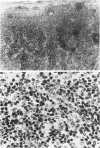Abstract
The authors applied a battery of monoclonal antibodies to T cells and other hematolymphoid cells on frozen tissue sections of lymph nodes with involvement by MF and DL, both with and without a history of MF. All 13 lymph nodes showing histologic involvement with MF showed immunophenotypic abnormalities. All of these cases showed significant loss of Leu-9 expression, and 10 cases showed significant loss of Leu-8 expression. In addition, occasional cases showed loss of the pan-T-cell markers Leu-1, 4, and 5. All cases of DL of histologic grade LN-0 or 1, with or without a history of MF, showed a predominance of T helper cells in paracortical regions without evidence of immunophenotypic abnormalities. Three of the 4 cases of DL of histologic grade LN-2 or 3 showed significant loss of Leu-8 and/or Leu-9 expression identified by a decrease in the ratio of paracortical Leu-8/Leu-4 or Leu-9/Leu-4-expressing cells, all cases with a history of possible or definite MF. These results raise the possibility that the immunologic methods employed may be able to identify cases of DL with early involvement by MF.
Full text
PDF






Images in this article
Selected References
These references are in PubMed. This may not be the complete list of references from this article.
- Berger C. L., Warburton D., Raafat J., LoGerfo P., Edelson R. L. Cutaneous T-cell lymphoma: neoplasm of T cells with helper activity. Blood. 1979 Apr;53(4):642–651. [PubMed] [Google Scholar]
- Broder S., Edelson R. L., Lutzner M. A., Nelson D. L., MacDermott R. P., Durm M. E., Goldman C. K., Meade B. D., Waldmann T. A. The Sézary syndrome: a malignant proliferation of helper T cells. J Clin Invest. 1976 Dec;58(6):1297–1306. doi: 10.1172/JCI108585. [DOI] [PMC free article] [PubMed] [Google Scholar]
- Burke J. S., Colby T. V. Dermatopathic lymphadenopathy. Comparison of cases associated and unassociated with mycosis fungoides. Am J Surg Pathol. 1981 Jun;5(4):343–352. [PubMed] [Google Scholar]
- Clendenning W. E., Rappaport H. W. Report of the Committee on Pathology of Cutaneous T Cell Lymphomas. Cancer Treat Rep. 1979 Apr;63(4):719–724. [PubMed] [Google Scholar]
- Colby T. V., Burke J. S., Hoppe R. T. Lymph node biopsy in mycosis fungoides. Cancer. 1981 Jan 15;47(2):351–359. doi: 10.1002/1097-0142(19810115)47:2<351::aid-cncr2820470224>3.0.co;2-4. [DOI] [PubMed] [Google Scholar]
- Erkman-Balis B., Rappaport H. Cytogenetic studies in mycosis fungoides. Cancer. 1974 Sep;34(3):626–633. doi: 10.1002/1097-0142(197409)34:3<626::aid-cncr2820340320>3.0.co;2-9. [DOI] [PubMed] [Google Scholar]
- Fuks Z. Y., Bagshaw M. A., Farber E. M. Prognostic signs and the management of the mycosis fungoides. Cancer. 1973 Dec;32(6):1385–1395. doi: 10.1002/1097-0142(197312)32:6<1385::aid-cncr2820320617>3.0.co;2-#. [DOI] [PubMed] [Google Scholar]
- Gatenby P. A., Kansas G. S., Xian C. Y., Evans R. L., Engleman E. G. Dissection of immunoregulatory subpopulations of T lymphocytes within the helper and suppressor sublineages in man. J Immunol. 1982 Nov;129(5):1997–2000. [PubMed] [Google Scholar]
- Guccion J. G., Fischmann A. B., Bunn P. A., Jr, Schechter G. P., Patterson R. H., Matthews M. J. Ultrastructural appearance of cutaneous T cell lymphomas in skin, lymph nodes, and peripheral blood. Cancer Treat Rep. 1979 Apr;63(4):565–570. [PubMed] [Google Scholar]
- Haynes B. F., Metzgar R. S., Minna J. D., Bunn P. A. Phenotypic characterization of cutaneous T-cell lymphoma. Use of monoclonal antibodies to compare with other malignant T cells. N Engl J Med. 1981 May 28;304(22):1319–1323. doi: 10.1056/NEJM198105283042202. [DOI] [PubMed] [Google Scholar]
- Kung P. C., Berger C. L., Goldstein G., LoGerfo P., Edelson R. L. Cutaneous T cell lymphoma: characterization by monoclonal antibodies. Blood. 1981 Feb;57(2):261–266. [PubMed] [Google Scholar]
- Link M., Warnke R., Finlay J., Amylon M., Miller R., Dilley J., Levy R. A single monoclonal antibody identifies T-cell lineage of childhood lymphoid malignancies. Blood. 1983 Oct;62(4):722–728. [PubMed] [Google Scholar]
- Schechter G. P., Bunn P. A., Fischmann A. B., Matthews M. J., Guccion J., Soehnlen F., Munson D., Minna J. D. Blood and lymph node T lymphocytes in cutaneous T cell lymphoma: evaluation by light microscopy. Cancer Treat Rep. 1979 Apr;63(4):571–574. [PubMed] [Google Scholar]
- Scheffer E., Meijer C. J., Van Vloten W. A. Dermatopathic lymphadenopathy and lymph node involvement in mycosis fungoides. Cancer. 1980 Jan 1;45(1):137–148. doi: 10.1002/1097-0142(19800101)45:1<137::aid-cncr2820450124>3.0.co;2-k. [DOI] [PubMed] [Google Scholar]
- Whang-Peng J., Bunn P., Knutsen T., Schechter G. P., Gazdar A. F., Matthews M. J., Minna J. D. Cytogenetic abnormalities in patients with cutaneous T-cell lymphomas. Cancer Treat Rep. 1979 Apr;63(4):575–580. [PubMed] [Google Scholar]
- Wood G. S., Deneau D. G., Miller R. A., Levy R., Hoppe R. T., Warnke R. A. Subtypes of cutaneous T-cell lymphoma defined by expression of leu-1 and Ia. Blood. 1982 May;59(5):876–882. [PubMed] [Google Scholar]
- Wood G. S., Warnke R. A. The immunologic phenotyping of bone marrow biopsies and aspirates: frozen section techniques. Blood. 1982 May;59(5):913–922. [PubMed] [Google Scholar]
- Yanagihara E. T., Parker J. W., Meyer P. R., Cain M. J., Hofman F., Lukes R. J. Mycosis fungoides/Sezary's syndrome progressing to immunoblastic sarcoma. A T-cell lymphoproliferation with both helper and suppressor phenotypes. Am J Clin Pathol. 1984 Feb;81(2):249–257. doi: 10.1093/ajcp/81.2.249. [DOI] [PubMed] [Google Scholar]






